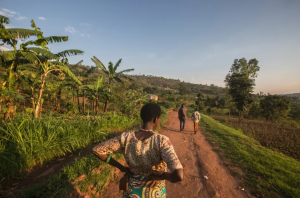A few weeks ago, I decided to follow up my foray into what seemed the most foreign of “cultural” events in Rwanda — the country’s biggest beauty pageant — with something that surely must be among the most Rwandan: the opening of the Museum of Ancient Rwandan History.
The government and some private partners have restored the home of the last king of Rwanda, Mutara the III. No one seems too troubled by the irony of putting Rwanda’s Ancient History museum in a clearly colonial structure, only ever inhabited by its least ancient of indigenous rulers.
Nor do they seem to concerned with the irrationality of protocol here: You must take off your shoes to enter, either walking through in your socks (though I saw some bare feet) or slipping one of the dozen pairs of soft, brown leather sandals, all identical in size. I can only assume the shoes are to protect the carpet—a commodity which exists in no home I’ve entered in Rwanda, and which I can’t even remember seeing in any public building. But it’s the kind of carpet we use in our public schools back home, and so the ceremony of the shoes seems somehow out of proportion.
There’s not a great amount of text here—and it’s all in the museum catalog, so you could conceivably skip visiting this place entirely if you borrow the book I overpaid for—and the most interesting person to emerge from the sketch of history here is the former resident himself.
Mutara III was Rwanda’s last king, brought to power after his father, an agitated anti-colonialist, was dethroned and sent off to Congo (he died there in 1944; no word, at the museum, on how). Mutara III was seen to be rather more Belgian-friendly, and at first he was. But as plane travel expanded and the Rwandan diaspora became more independent, more vocal, and more united, Mutara began to get some rather anti-Belgian ideas. He died mysteriously in 1959–the year the Belgians handed the colony over to UN Trusteeship, in the process reversing decades of privilege granted to Tutsis and handing over political power to the Hutu. That set up a political system that would institutionalize both social and economic disenfranchisement and flat-out murder—against the once-“superior” Tutsi minority.
Mutara III’s former home tells the story of everything leading up to that point—of everything, I am tempted to say, that no one knows about Rwanda.
The museum is in Rukari, which is about 2.5 kilometers from Nyanza, a village so surprisingly big to me that I want to call it a town. (And yes, I think Kigali is a “city.”) Nyanza became the royal capital of Rwanda in 1899 , just before the German colonists showed up. (Historical footnote: Rwanda was ruled by the Germans from 1890 or so to 1919 and handed over to Belgium when the world divvied up Germany’s assets at the end of World War I.)
Ministers there called Nyanza the “cultural capital” of Rwanda and made a plea to develop the place with the same seriousness as the sites of “eco-tourism” out West, where boatloads of white people pay $500 a pop to hike through the forest and look at monkeys. (Er, silverback gorillas. You know, fancy monkeys.)
I didn’t look for a moto from Nyanza to Rukari because I wanted to soak up a totally new place while moving at the speed of human thought, but I also didn’t see that many while I walked; the parking lot of the museum was choked by Land Rovers with diplomatic plates. Point being, I’m not sure how you’re going to make a tourist mecca of a “cultural capital” that’s so difficult to get to, but maybe it’ll work out.
There’s also not all that much out here, to be honest. Granted, I didn’t see the Rwesero Arts Museum– also intended as a home for Mutara the III, whose mysterious death kept him from ever living there.
In fact, if I were the Rwandan minister of culture or of museums or what have you, that’s what I’d do: I’d sell that story. I’d start with the mysterious death of a king who had agitated the foreign rulers that would go out of their way to screw the country before they left, and I’d work backwards, historically. Sure, it means you have to make the Belgians the villain, but the Belgians are already the villains in Rwandans’ collective memory, a role the official narratives here reinforce with vigor. So why not use it on the tourists, too?
After all, everyone knows the white Western world likes nothing more than a good mea culpa. O, the market in historical schadenfreude is vast and unexplored!




amazing how those kinds of places draw people…
i can only speak from visiting gettysburg… my father was an historian.. i remember the whispers of people walking the place, overcome by the numbers who died. that they walked on soil drenched with blood of americans killed by americans… for america.
it’s packed.
and quiet.
and so sad, it hurts.